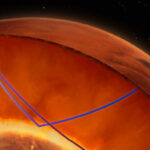Venus is the least understood of the terrestrial planets. Despite broad similarities to the Earth in mass and size, Venus has no evidence of plate tectonics recorded on its young surface, and Venus’ atmosphere is strikingly different. New research from Brown University offers evidence that Venus had plate tectonics billions of years ago.
This composite image, taken by JAXA’s Akatsuki spacecraft, shows Venus. Image credit: JAXA / ISAS / DARTS / Damia Bouic.
Plate tectonics is a process critical to life that involves multiple continental plates pushing, pulling and sliding beneath one another.
On Earth, this process intensified over billions of years, forming new continents and mountains, and leading to chemical reactions that stabilized the planet’s surface temperature, resulting in an environment more conducive to the development of life.
Venus, on the other hand, Earth’s nearest neighbor and sister planet, went in the opposite direction and today has surface temperatures hot enough to melt lead.
One explanation is that the planet has always been thought to have what’s known as a stagnant lid, meaning its surface has only a single plate with minimal amounts of give, movement and gasses being released into the atmosphere.
A new paper published in the journal Nature Astronomy posits that this wasn’t always the case.
To account for the abundance of nitrogen and carbon dioxide present in Venus’ atmosphere, the authors conclude that Venus must have had plate tectonics sometime after the planet formed, about 4.5 billion to 3.5 billion years ago.
They suggest that this early tectonic movement, like on Earth, would have been limited in terms of the number of plates moving and in how much they shifted. It also would have been happening on Earth and Venus simultaneously.
“One of the big picture takeaways is that we very likely had two planets at the same time in the same Solar System operating in a plate tectonic regime — the same mode of tectonics that allowed for the life that we see on Earth today,” said Dr. Matt Weller, who completed the work while he was a postdoctoral researcher at Brown University and is now at the Lunar and Planetary Institute.
“This bolsters the possibility of microbial life on ancient Venus and shows that at one point the two planets — which are in the same Solar neighborhood, are about the same size, and have the same mass, density and volume — were more alike than previously thought before diverging.”

Artist’s impression of a volcano erupting on Venus. Image credit: ESA / AOES Medialab.
The work also highlights the possibility that plate tectonics on planets might just come down to timing — and therefore, so may life itself.
“We’ve so far thought about tectonic state in terms of a binary: it’s either true or it’s false, and it’s either true or false for the duration of the planet,” said Dr. Alexander Evans, a planetary researcher at Brown University.
“This shows that planets may transition in and out of different tectonic states and that this may actually be fairly common. Earth may be the outlier. This also means we might have planets that transition in and out of habitability rather than just being continuously habitable.”
That concept will be important to consider as scientists look to understand nearby moons — like Jupiter’s Europa, which has shown proof of having Earth-like plate tectonics — and distant exoplanets.
The researchers initially started the work as a way to show that the atmospheres of far-off exoplanets can be powerful markers of their early histories, before deciding to investigate that point closer to home.
They used current data on Venus’ atmosphere as the endpoint for their models and started by assuming Venus has had a stagnant lid through its entire existence.
Quickly, they were able to see that simulations recreating the planet’s current atmosphere didn’t match up with where the planet is now in terms of the amount nitrogen and carbon dioxide present in the current atmosphere and its resulting surface pressure.
The scientists then simulated what would have had to happen on the planet to get to where it is today.
They eventually matched the numbers almost exactly when they accounted for limited tectonic movement early in Venus’ history followed by the stagnant lid model that exists today.
Overall, they believe the work serves as a proof of concept regarding atmospheres and their ability to provide insights into the past.
“We’re still in this paradigm where we use the surfaces of planets to understand their history,” Dr. Evans said.
“We really show for the first time that the atmosphere may actually be the best way to understand some of the very ancient history of planets that is often not preserved on the surface.”
_____
M.B. Weller et al. Venus’s atmospheric nitrogen explained by ancient plate tectonics. Nat Astron, published online October 26, 2023; doi: 10.1038/s41550-023-02102-w




